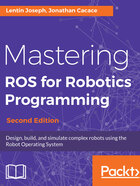
上QQ阅读APP看书,第一时间看更新
Why some do not prefer ROS for robots
Here are some of the reasons why some people do not prefer ROS for their robotic projects:
- Difficulty in learning: ROS can be difficult to learn. It has a steep learning curve and developers should become familiar with many new concepts to get benefits from the ROS framework.
- Difficulties in starting with simulation: The main simulator in ROS is Gazebo. Even though Gazebo works well, to get started with Gazebo is not an easy task. The simulator has no inbuilt features to program. Complete simulation is done only through coding in ROS. When we compare Gazebo with other simulators, such as V-REP and Webots, they have inbuilt functionalities to prototype and program the robot. They also have a rich GUI toolset support a wide variety of robots and have ROS interfaces too. These tools are proprietary but can deliver a decent job. The toughness of learning simulation using Gazebo and ROS is a reason for not using it in projects.
- Difficulties in robot modeling: The robot modeling in ROS is performed using URDF, which is an XML-based robot description. In short, we need to write the robot model as a description using URDF tags. In V-REP, we can directly build the 3D robot model in the GUI itself, or we can import the mesh. In ROS, we should write the robot model definitions using URDF tags. There is a SolidWorks plugin to convert a 3D model from SolidWorks to URDF, but if we use other 3D CAD tools, there are no options at all. Learning to model a robot in ROS will take a lot of time, and building using URDF tags is also time-consuming compared to other simulators.
- Potential limitations: Current ROS versions have some limitations. For example, there is a lack of a native real-time application development support or the complexity to implement robust multi-robot distributed applications.
- ROS in commercial robot products: When we deploy ROS on a commercial product, a lot of things need to be taken care of. One thing is the code quality. ROS code follows a standard coding style and keeps best practices for maintaining the code too. We have to check whether it satisfies the quality level required for our product. We might have to do additional work to improve the quality of the code. Most of the code in ROS is contributed by researchers from universities, so if we are not satisfied with the ROS code quality, it is better to write our own code, which is specific to the robot and only use the ROS core functionalities if required.
We now know where we have to use ROS and where we do not. If ROS is really required for your robot, let's start discussing ROS in more detail. First, we can see the underlying core concepts of ROS. There are mainly three levels in ROS: the filesystem level, computation graph level, and community level. We will briefly have a look at each level.